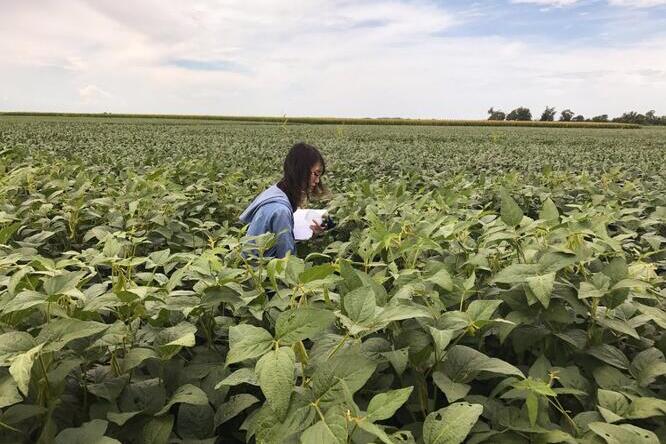2022-11-01 イリノイ大学アーバナ・シャンペーン校

Study author Heng-An Lin studying fungi in soybean field
研究者たちは、圃場試験で使用するダイズの苗の半分にセプトリアを接種した。そして、遺伝子情報と高度なバイオインフォマティクス解析を用いて、シーズン中、殺菌剤を散布する前と後の葉の菌類を同定した。
フラックスピロキサートとピラクロストロビンを混合したこの殺菌剤を選んだのは、現在アメリカ中西部でごく普通に使われているからである。
この殺菌剤は多くの菌類をノックアウトしたが、やはりセプトリアはダメだった。研究者は、殺菌剤がセプトリアの競争相手を排除し、病原菌を繁殖させたと考えている。
<関連情報>
- https://aces.illinois.edu/news/3300-hidden-fungi-coat-soybean-plants-new-research-explains-significance
- https://apsjournals.apsnet.org/doi/10.1094/PBIOMES-12-21-0075-R
ダイズフィロスフィアミコバイオームに対するSeptoria glycinesおよび殺菌剤散布の影響 The effect of Septoria glycines and fungicide application on the soybean phyllosphere mycobiome
Heng-An Lin and Santiago Mideros
Phytobiomes Published:29 Jul 2022
DOI:https://doi.org/10.1094/PBIOMES-12-21-0075-R
Abstract
Septoria brown spot, caused by Septoria glycines, is Illinois’ most prevalent soybean disease. It is common to use foliar fungicides to control Septoria brown spot and other late-season diseases of soybean. The effects of fungicide on non-target organisms in the phyllosphere are unknown. To study the effect of S. glycines and fungicide application on the soybean phyllosphere mycobiome, we conducted a replicated field trial and collected samples at three soybean developmental stages. Then we sequenced full-length ITS and a partial LSU region using oxford nanopore technologies. Sequencing and data analysis produced 3,342 operational taxonomic units. The richness of the fungal community increased with the host development. There were differences in mycobiome diversity between soybean lines at the early developmental stage but not at the reproductive stages. Inoculation with S. glycines did not affect the alpha diversity, but some significant changes were observed for the beta diversity. At the beginning seed stage (R5), fungicide application changed the composition of the fungal community. The fungicide treatment decreased the proportion of several fungal taxa but it increased the proportion of Septoria. The core mycobiome in the phyllosphere was composed of Gibberella, Alternaria, Didymella, Cladosporium, Plectosphaerella, Colletotrichum, and Bipolaris. Network analysis identified significant interactions between Septoria and Diaporthe, Bipolaris, and two other taxonomic units. In this study, we set Septoria as the target organism and demonstrated that metabarcoding could be a tool to quantify the effect of multiple treatments on the mycobiome community.


